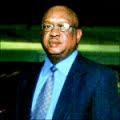Davis was also implicated in the abortion deaths of Anna Adler , Mary Whitney, Anna Borndal, Irene Kirschner, and Gertrude Gaesswitz.
 |
| Dr. Lou E. Davis |
The same can't be said about the 1992 death of Suzanne Logan. What passed for "care" at the deplorable Maryland abortion mill was so appalling that even 60 Minutes stopped and paid attention.
 |
| Dr. Gideon Kioko |
Eventually somebody summoned emergency medical services (EMS). The EMS personnel reported that the Hillview employees seemed "very confused and did not seem to know what they were doing." EMS staff also noted that Hillview staff had put an oxygen mask on Suzanne upside-down, so that she wasn't getting any oxygen.
Suzanne was blue from lack of oxygen, limp, had no pulse and was not breathing. EMS workers managed to perform CPR and get Suzanne's heart and lungs working again, and transported her to a hospital. Suzanne remained comatose and was transferred to a nursing home. Four months after the abortion, she regained consciousness, but was paralyzed and unable to speak. She had no memory of the abortion, but was able to eventually recall having gone to the clinic.
Local prolifers visited Suzanne, and bought her a device that allowed her to communicate. She was interviewed by 60 Minutes, and asked what she wanted. She replied, "To go home."
Suzanne filed suit against Kioko and the clinic. In November of 1992, she finally won her suit, and was awarded $2.6 million and $10,000 a month for life, to cover her expenses. Sadly, Suzanne died on December 1, before she had a chance to fulfill her wish of seeing her father again.
When 60 Minutes interviewed Barbara Radford, then-president of the National Abortion Federation, she defended the head-in-the-sand attitude the organization took toward safety issues by saying, "We want to make sure that women have choices when it comes to abortion services, and if you regulate it too strictly, you then deny women access to the service." When they asked pro-choice Maryland State Senator Mary Boergers why nothing was being done to address dangerous abortion clinics. Boergers said, "There's only so much of a willingness to try to push a group like the pro-choice movement to do what I think is the responsible thing to do because they then treat you as if you're the enemy."
That attitude toward the deplorable conditions at Hillview cost Suzanne, as well as abortion patient Debra Gray their lives. And that "see no evil" mentality persists to this day, as evidenced by the results we saw when prochoicers decided to turn a blind eye to Kermit Gosnell's Philadelphia "house of horrors" where two abortion patients were fatally injured and uncounted numbers of viable, live-born infants killed with a "snip" to the spinal cord.
Abortion was legalized ostensibly to prevent the deaths of women like Esther Wahlstrom. But legalization proponents did nothing to protect Suzanne Logan, Debra Gray, and other women who have lost their lives to abortion quackery.
No comments:
Post a Comment